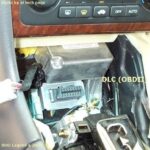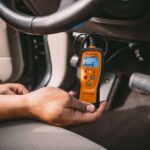A check engine light can be concerning, especially for Mitsubishi owners. Understanding how to diagnose the issue without a specialized scanner can save time and money. This guide explores various methods to read OBD2 codes on a Mitsubishi without a scanner.
While a professional diagnostic tool offers the most accurate reading, these alternative techniques can provide valuable insights into the underlying problem triggering the check engine light. Knowing the potential causes empowers you to make informed decisions about repairs.
Understanding Mitsubishi’s OBD2 System
Mitsubishi, like most modern vehicles, utilizes the OBD2 (On-Board Diagnostics II) system. This system monitors various engine and emission components, detecting malfunctions and storing corresponding diagnostic trouble codes (DTCs). Accessing these codes is crucial for troubleshooting.
Methods for Reading OBD2 Codes Without a Scanner on Mitsubishi
Several methods exist for retrieving DTCs without a scanner, specifically for some older Mitsubishi models:
Method 1: Using the Odometer
Some Mitsubishi models allow code retrieval through the odometer:
- Turn the ignition to the “ON” position without starting the engine.
- Press and hold the odometer trip reset button.
- While holding the reset button, turn the ignition to the “OFF” position and then back to “ON.”
- Continue holding the reset button until a series of numbers or letters appear on the odometer display. These represent the DTCs.
Method 2: Using the Ignition Key
This method involves cycling the ignition key:
- Ensure the ignition is “OFF.”
- Turn the ignition key “ON,” “OFF,” “ON” in rapid succession without starting the engine.
- Observe the check engine light. It may flash a series of long and short blinks, representing the DTCs. Refer to a Mitsubishi specific OBD2 code chart to interpret the flashes.
Method 3: Checking for Diagnostic Connectors
Some older Mitsubishi models may have dedicated diagnostic connectors under the dashboard or in the engine bay. Shorting specific pins on these connectors with a jumper wire can trigger the check engine light to flash DTCs. Consult your vehicle’s repair manual for connector locations and pin configurations.
Important Considerations
These methods may not work on all Mitsubishi models, particularly newer ones with more advanced computer systems. Furthermore, interpreting the codes accurately requires a Mitsubishi-specific OBD2 code chart.
Misinterpreting codes can lead to incorrect diagnoses and unnecessary repairs. While these methods offer a starting point for troubleshooting, consulting a qualified mechanic with a professional scanner is recommended for a definitive diagnosis and repair.
When to Seek Professional Help
If the check engine light persists or the DIY methods prove inconclusive, it’s crucial to seek professional assistance. A qualified mechanic can accurately diagnose the issue using a professional-grade OBD2 scanner and recommend appropriate repairs.
Conclusion
Understanding how to read OBD2 codes without a scanner on a Mitsubishi can be helpful in preliminary diagnostics. However, these methods are not always reliable and may not work on all models. For accurate diagnosis and effective repairs, consulting a professional mechanic is always recommended. Addressing check engine light issues promptly helps prevent further damage and ensures optimal vehicle performance and safety.

